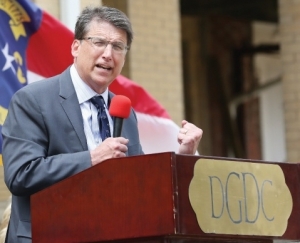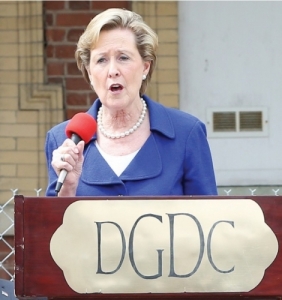Credits for history
By Ethan Smith
Published in News on April 8, 2015 1:46 PM

News-Argus/CASEY MOZINGO
Gov. Pat McCrory visited Goldsboro Tuesday to urge residents to speak out in favor of historic preservation tax credits. McCrory gave a press conference at Union Station before touring downtown.

News-Argus/CASEY MOZINGO
State Department of Cultural Resources Secretary Susan Kluttz said renewing historic preservation tax credits is an urgent need in order to keep the history of North Carolina alive.
Gov. Pat McCrory and state Department of Cultural Resources Secretary Susan Kluttz toured downtown Goldsboro Tuesday afternoon to discuss the importance of renewing historical preservation tax credits in the state.
McCrory and Kluttz kicked off their visit to Goldsboro by holding a press conference in front of historic Union Station at the intersection of Walnut Street and Carolina streets.
The credits officially expired on Jan. 1 after the state Senate eliminated them as part of a tax reform bill approved in 2013.
They were originally instated in 1998, and 90 of 100 North Carolina counties have used the tax credits in the past to revitalize main streets and historic buildings, bringing $1.67 billion in investment to the state over two decades.
A bill to reinstate the tax credits passed in the North Carolina House about a week ago, but has not advanced in the Senate.
McCrory and Mrs. Kluttz stopped in Goldsboro as part of their awareness tour for the urgency and need to renew the credits.
"Goldsboro is my 53rd stop since January first, and the 34th city or town we've been to," Mrs. Kluttz said. "I find that most citizens in North Carolina have no idea what the tax credits are, so we are raising awareness about the credits and just how much they help communities like Goldsboro."
Goldsboro and Wayne County have seen $5.1 million of investment in the rehabilitation of historic properties since the credits became available in 1998.
Starting in 2001, there have been 10 homeowner rehabilitation projects in Goldsboro and Mount Olive that were partially funded by the historic preservation tax credits. There have also been five income-producing rehabilitation projects since 2001, making a total of 15 tax credit projects completed in Goldsboro and Wayne County, bringing millions of dollars to the community.
"What I hear in Raleigh is that the elimination of historic preservation tax credits is about a philosophy of tax reform," Mrs. Kluttz said. "What I don't hear anybody realize is that this is the history of North Carolina they're doing away with."
"When a business is thinking about moving their industry into a town, the first place they want to see is the town's center -- the town's main street," McCrory said. "Because if you have a strong main street it shows that you have a viable future."
Historic buildings must not fall into blight, McCrory said, because blight and dilapidation spread throughout communities one building at a time.
"If we have empty buildings and blight in communities, it makes it harder to sell the town to industry," McCrory said. "Blight cascades -- one building becomes empty and dilapidated, then the next one does. But revitalization cascades, too. So we have a choice: Do we grow revitalization or do we grow blight?"
After the press conference, McCrory and Mrs. Kluttz boarded a Goldsboro-Wayne Transportation Authority bus to tour downtown.
At the Edgerton Apartments, they said they were impressed with what they saw.
When Bill and Jan Edgerton opened the doors to their apartments, Gov. McCrory had only one thing to say.
"This is amazing," he said.
The Capt. J.B. Edgerton building, where the apartments are located, was built in 1900, and rehabilitated in 2013 and 2014 with the use of historic preservation tax credits in order to add four new apartments on the second floor. The entire project totaled $560,000.
